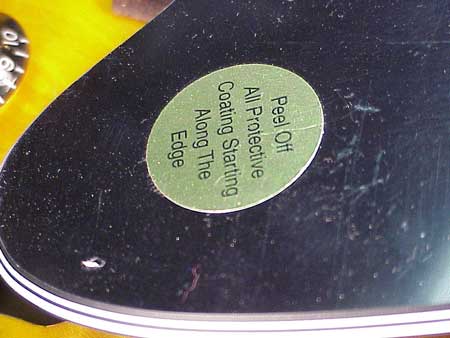Archtop Guitar Setup
© Frank Ford, 7/3/00; Photos by FF, 7/2/00
Archtop guitars are for playing jazz. (Certainly they are not exactly synonymous with jazz, but they are the predominant tool for jazz players.)
Lots of jazz guitars are electric instruments:

And electric components have lots of their own requirements for setup. Since FRETS.COM is an acoustic place, I'll ignore the electronic part, and concentrate on the acoustic elements of the jazz guitar.
Most of the setup and adjustment considerations are similar to other steel string acoustic instruments, including truss rod adjustments and nut action
Here are a couple of topics unique to the archtop instrument design.
Because the bridge is movable, and is held in position only by the downward force of string tension, it needs to be repositioned from time to time to achieve good intonation.
The easiest way to accomplish this is to play the harmonic at the twelfth fret, and compare that note to the note made by the same string actually fretted at the twelfth fret:

If the fretted note is sharp compared to the open harmonic note, then the bridge needs to be moved toward the tailpiece a bit:

Obviously, if the fretted note is flat, the bridge needs to go the other direction, toward the neck. By repeating this process with the various strings, you can reach the ideal bridge position in relatively short order. Usually, you can slide the bridge while the instrument is tuned to pitch, although sometimes it may be necessary to slack off the strings to move the bridge without damaging the top finish. Often you can get the bridge in a good position by using just the two "E" strings, leaving the others detuned completely until the bridge is where you want it.
A typical acoustic archtop bridge looks like this, with individual string scale length compensation built into the top:

Gibson developed, and others copied an individually adjustable bridge top:

The top of this bridge is so massive that it affects the acoustic tone. It offers nearly perfect intonation because each string can be "dialed in" to the best effect. There's something of a tradeoff here, tonality vs. intonation.
The archtop jazz guitar usually offers easy action adjustment:

Simply screw the bridge up or down as desired. It couldn't be simpler to find the best action height. Depending on the instrument, tuning, string gauge and bridge height, it may be necessary to reduce string tension to adjust the action upward, but in virtually all cases, it's easy to lower the action while the guitar is tuned to pitch.
Unlike their flat top counterparts, archtop jazz guitars usually have an array of things screwed to the body, such as this fingerrest support:

It's a good idea to keep an eye on these things, checking them for tightness from time to time. The vibration of the instrument when played, bumping in and out of cases, and any number of small accidents can loosen various parts, causing them to rattle.
Speaking of fingerrests, take a look at this little sticker on a new Gibson guitar:

Good advice. A fingerrest or pickguard is usually made of plastic, and often comes with this protective skin on the surface. If it's left on for too long, it can be mighty difficult to remove. The plastic surface can always be repolished if it gets lots of pick scratches.
As the plastic ages, it may warp and become a source of extraneous rattles:

This one has as felt block added to help keep it off the face of the guitar.
Back to Index Page